Openwrt很小巧,底层是基于类Debian的linux系统,既可以做嵌入式系统,也可以编译成x86的系统在PC上跑。NextCloud是一套不错的开源云盘程序,基于PHP开发。
本文记录了如何在Openwrt上安装配置NextCloud的例子。
此例所有操作在ubuntu下进行,用virtualbox的虚机模拟。
openwrt主机IP设置为192.168.100.1。
没有用https,考虑到这个一般是个人做云盘,野证书实在意义不大,还老被浏览器拦截,烦。
以前用过一个一键安装的脚本,体验不是很好。目前大火的DOCKER也没觉得方便到哪去,至少在openwrt上,冗余太多。
调优玩法很多,本文只是最低限度的修改一些配置让整个系统能跑起来。
尽量做到数据和系统分离,备份出来的配置回刷也不要紧,方便openwrt系统升级。
第一步 编译openwrt
选择release的版本,比如21.02。不推荐用最新的源码编译,那个还不稳定,有很多问题的。
包选择:
Nginx所有
Mariadb所有
PHP所有
Openssl-util 必需,就算不用https也需要的。
Luci任意,不想多个uhttpd就选择nginx版本的luci,反正nginx是逃不掉的。
Base system里blockd(block-mount会自动被选中),用于自动挂载附加的磁盘。
可选的:shadow-util,Aria2,bind-tool,wget
其它根据自己喜好选,如果要用DDNS就需要带上bind-tool,wget
Aria2是不错的,带上,后期在NC里面可以挂远程下载的ocDownloader插件。其它的缺啥不要紧,后期可以再装。
设置:
Target image里可以设置生成镜像的选项,如果要刻到U盘,就不要选GZIP images。根目录大小500M就够了,太大生成镜像时很慢还占硬盘。不够了后期刻好U盘后可以再扩容。
Image configuration > Preinit configuration options里可以设置初始的网卡IP地址,默认第一块网卡(eth0)是LAN,第二块(eth1)是WAN,如果你是双网卡的话。
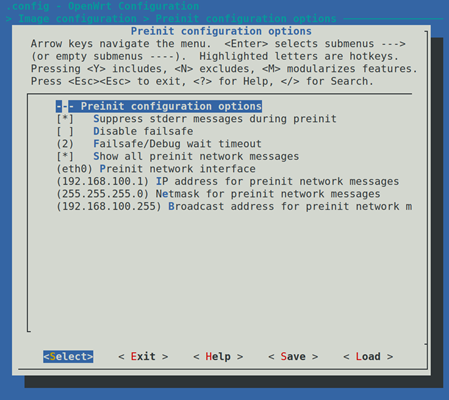
刻U盘推荐rufus,真心好用。
第二步 设置nginx
把蛋疼的uci给毙了,vi etcconfignginx
config main global
option uci_enable 'false'
进到etcnginx执行下面操作
cp uci.conf conf.dluci.conf
cp uci.conf nginx.conf把新复制出来的nginx.conf裁剪成这样:
worker_processes auto;
user root;
events {
use epoll;
}
http {
access_log off;
log_format openwrt
'$request_method $scheme://$host$request_uri => $status'
' (${body_bytes_sent}B in ${request_time}s) <- $http_referer';
include mime.types;
default_type application/octet-stream;
sendfile on;
client_max_body_size 128M;
large_client_header_buffers 2 1k;
gzip on;
gzip_vary on;
gzip_proxied any;
include conf.d/*.conf;
}进到conf.d里面,把luci.conf裁剪成这样:
server {
listen 80;
listen [::]:80;
server_name luci;
root /www;
include conf.d/luci.locations;
}
登录下http://192.168.100.1,如果luci好使,说明nginx就正常在运行了。
第三步 挂载主硬盘
主硬盘要先格式化好,分区最好是EXT4的,其它的没试过。
进luci,system菜单里有mount points,如果没有,执行opkg install blockd,应该就有了。
选中你的主硬盘,勾enabled,save&apply就行了。如果没有找到要挂载的硬盘,点一下页面上方的Generate config。

默认是挂到/mnt/sda1里。
第四步 设置Mariadb(mysql)
vi /etc/config/mysqld,修改成这样,让mysql可以自动启动:
config mysqld 'general'
option enabled '1' # 0 - disabled, 1 - enabled
#option options '--syslog' # Options passed to mysqld_safe创建数据库目录,mkdir /mnt/sda1/mysql
编辑mysql配置文件,vi /etc/mysql/conf.d/50-server.cnf,修改datadir参数对应上面创建的目录:
# Don't put this on flash memory
# Figure out where you are going to put the databases and run
# mysql_install_db --force
datadir = /mnt/sda1/mysql执行mysql_install_db --force初始化数据库,如果/mnt/sda1/mysql下有一堆文件生成,那就成功了。
Reboot一下,htop看看有没有mysqld的进程,正常会有一大串的。
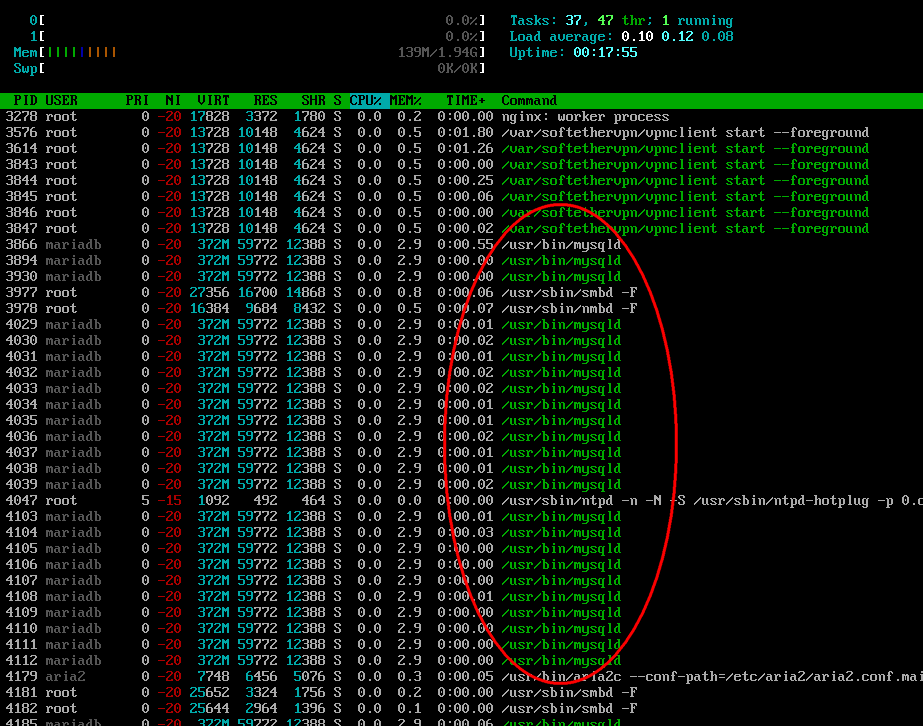
设置mysql的root密码,mysqladmin -uroot password xxxxxx,xxxxxx就是要设置的新密码。
第五步 安装phpmyadmin
如果不需要,这步可略过。
创建目录,mkdir /mnt/sda1/www
下载最新的phpmyadmin,放到上面创建的www目录里。
wget https://files.phpmyadmin.net/phpMyAdmin/5.0/phpMyAdmin-5.0-all-languages.zip
或者下载好了用scp传进去。
在/mnt/sda1/www下,unzip phpMyAdmin-5.1.0-all-languages.zip,把解压出来的目录改短,比如pma。
创建pma的nginx配置文件, touch /etc/nginx/conf.d/pma.conf,编辑内容如下:
server {
listen 3030;
root /mnt/sda1/www/pma;
index index.html index.php;
location ~ .php$ {
include fastcgi_params;
fastcgi_param SCRIPT_FILENAME $document_root$fastcgi_script_name;
fastcgi_index index.php;
fastcgi_pass unix:/var/run/php7-fpm.sock;
}
}
修改php.ini,vi /etc/php.ini,把doc_root=”/www”注释掉:
;doc_root = "/www"重启下nginx后,访问http://192.168.100.1:3030/setup,设置并生成config.inc.php,点击页面中的“新建服务器”: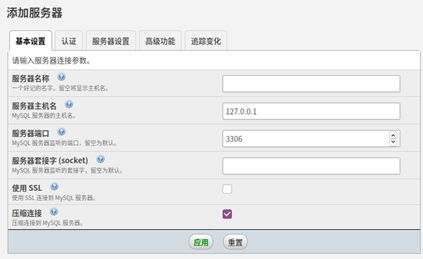
只需要填主机名和端口,“应用”后点“下载”,保存生成的config.inc.php:

把config.inc.php传进openwrt,
scp config.inc.php root@192.168.100.1:/mnt/sda1/www/pma创建mariadb的临时目录
mkdir /mnt/sda1/www/pma/tmp访问http://192.168.100.1:3030,登录后看页面下有警告信息,根据提示生成一下phpmyadmin自己的库,结束。新界面还挺好看的。
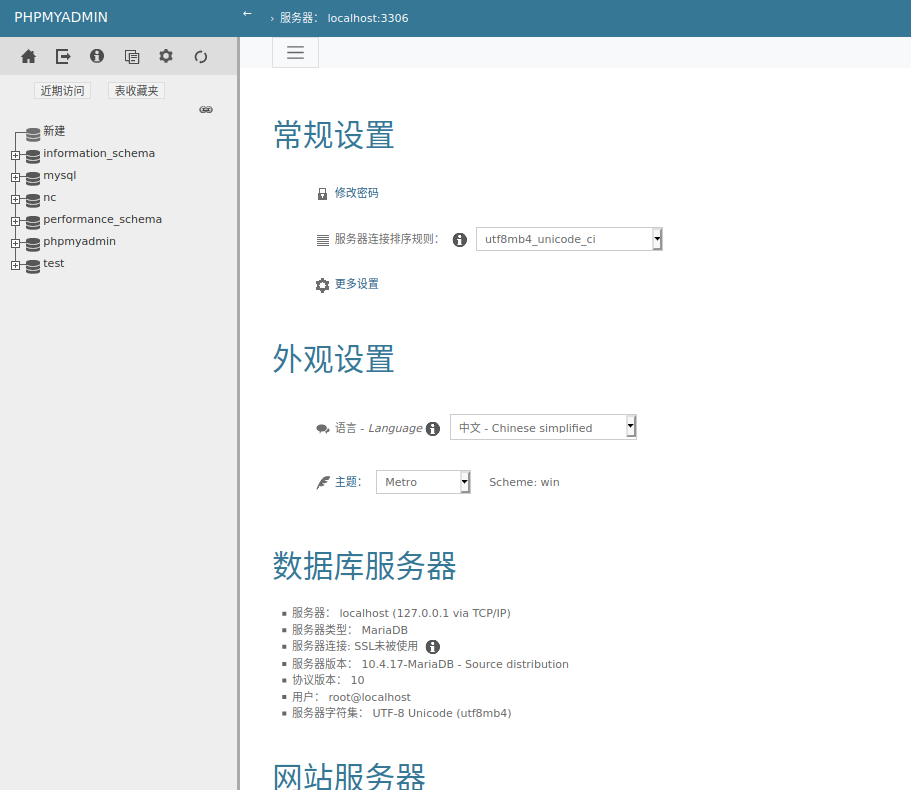
第六步 安装配置Nextcloud
写这篇文章时最新是20版的,下载链接,https://download.nextcloud.com/server/releases/nextcloud-20.1.zip
传到/mnt/sda1/www里,解压:
unzip nextcloud-21.0.1.zip改下目录名,短些方便:
mv nextcloud nc退到上级目录,修改文件夹属性:
chmod 777 nc -R
chown nobody:nogroup nc -R编辑生成/etc/nginx/conf.d/nc.conf,内容参考https://docs.nextcloud.com/server/21/admin_manual/installation/nginx.html,里面有两种配置,这里参考第一种,裁剪下去掉https支持:
upstream php-handler {
#server 127.0.0.1:9000;
server unix:/var/run/php7-fpm.sock;
}
server {
listen 3018;
listen [::]:3018;
#server_name cloud.example.com;
# Enforce HTTPS
#return 301 https://$server_name$request_uri;
# HSTS settings
# WARNING: Only add the preload option once you read about
# the consequences in https://hstspreload.org/. This option
# will add the domain to a hardcoded list that is shipped
# in all major browsers and getting removed from this list
# could take several months.
#add_header Strict-Transport-Security "max-age=15768000; includeSubDomains; preload;" always;
# set max upload size
client_max_body_size 512M;
fastcgi_buffers 64 4K;
# Enable gzip but do not remove ETag headers
gzip on;
gzip_vary on;
gzip_comp_level 4;
gzip_min_length 256;
gzip_proxied expired no-cache no-store private no_last_modified no_etag auth;
gzip_types application/atom+xml application/javascript application/json application/ld+json application/manifest+json application/rss+xml application/vnd.geo+json application/vnd.ms-fontobject application/x-font-ttf application/x-web-app-manifest+json application/xhtml+xml application/xml font/opentype image/bmp image/svg+xml image/x-icon text/cache-manifest text/css text/plain text/vcard text/vnd.rim.location.xloc text/vtt text/x-component text/x-cross-domain-policy;
# Pagespeed is not supported by Nextcloud, so if your server is built
# with the `ngx_pagespeed` module, uncomment this line to disable it.
#pagespeed off;
# HTTP response headers borrowed from Nextcloud `.htaccess`
add_header Referrer-Policy "no-referrer" always;
add_header X-Content-Type-Options "nosniff" always;
add_header X-Download-Options "noopen" always;
add_header X-Frame-Options "SAMEORIGIN" always;
add_header X-Permitted-Cross-Domain-Policies "none" always;
add_header X-Robots-Tag "none" always;
add_header X-XSS-Protection "1; mode=block" always;
# Remove X-Powered-By, which is an information leak
fastcgi_hide_header X-Powered-By;
# Path to the root of your installation
root /mnt/sda1/www/nc;
# Specify how to handle directories -- specifying `/index.php$request_uri`
# here as the fallback means that Nginx always exhibits the desired behaviour
# when a client requests a path that corresponds to a directory that exists
# on the server. In particular, if that directory contains an index.php file,
# that file is correctly served; if it doesn't, then the request is passed to
# the front-end controller. This consistent behaviour means that we don't need
# to specify custom rules for certain paths (e.g. images and other assets,
# `/updater`, `/ocm-provider`, `/ocs-provider`), and thus
# `try_files $uri $uri/ /index.php$request_uri`
# always provides the desired behaviour.
index index.php index.html /index.php$request_uri;
# Rule borrowed from `.htaccess` to handle Microsoft DAV clients
location = / {
if ( $http_user_agent ~ ^DavClnt ) {
return 302 /remote.php/webdav/$is_args$args;
}
}
location = /robots.txt {
allow all;
log_not_found off;
access_log off;
}
# Make a regex exception for `/.well-known` so that clients can still
# access it despite the existence of the regex rule
# `location ~ /(.|autotest|...)` which would otherwise handle requests
# for `/.well-known`.
location ^~ /.well-known {
# The following 6 rules are borrowed from `.htaccess`
location = /.well-known/carddav { return 301 /remote.php/dav/; }
location = /.well-known/caldav { return 301 /remote.php/dav/; }
# Anything else is dynamically handled by Nextcloud
location ^~ /.well-known { return 301 /index.php$uri; }
try_files $uri $uri/ =404;
}
# Rules borrowed from `.htaccess` to hide certain paths from clients
location ~ ^/(?:build|tests|config|lib|3rdparty|templates|data)(?:$|/) { return 404; }
location ~ ^/(?:.|autotest|occ|issue|indie|db_|console) { return 404; }
# Ensure this block, which passes PHP files to the PHP process, is above the blocks
# which handle static assets (as seen below). If this block is not declared first,
# then Nginx will encounter an infinite rewriting loop when it prepends `/index.php`
# to the URI, resulting in a HTTP 500 error response.
location ~ .php(?:$|/) {
fastcgi_split_path_info ^(.+?.php)(/.*)$;
set $path_info $fastcgi_path_info;
try_files $fastcgi_script_name =404;
include fastcgi_params;
fastcgi_param SCRIPT_FILENAME $document_root$fastcgi_script_name;
fastcgi_param PATH_INFO $path_info;
fastcgi_param HTTPS off;
fastcgi_param modHeadersAvailable true; # Avoid sending the security headers twice
fastcgi_param front_controller_active true; # Enable pretty urls
fastcgi_pass php-handler;
fastcgi_intercept_errors on;
fastcgi_request_buffering off;
}
location ~ .(?:css|js|svg|gif)$ {
try_files $uri /index.php$request_uri;
expires 6M; # Cache-Control policy borrowed from `.htaccess`
access_log off; # Optional: Don't log access to assets
}
location ~ .woff2?$ {
try_files $uri /index.php$request_uri;
expires 7d; # Cache-Control policy borrowed from `.htaccess`
access_log off; # Optional: Don't log access to assets
}
location / {
try_files $uri $uri/ /index.php$request_uri;
}
}
修改/etc/php.ini,把php可用内存,超时上限都加大:
; Resource Limits
max_execution_time = 300 ; Maximum execution time of each script, in seconds.
max_input_time = 600 ; Maximum amount of time each script may spend parsing request data.
;max_input_nesting_level = 64
memory_limit = 1024M ; Maximum amount of memory a script may consume.nextcloud要求PHP可用内存最小512M,土豪请任性。
reboot下,正常情况可以访问http://192.168.100.3018安装了:

安装完成可能会有那么一下下路径出错,稍等,重开浏览器尝试直接访问http://192.168.100.1:3018,祝好运!
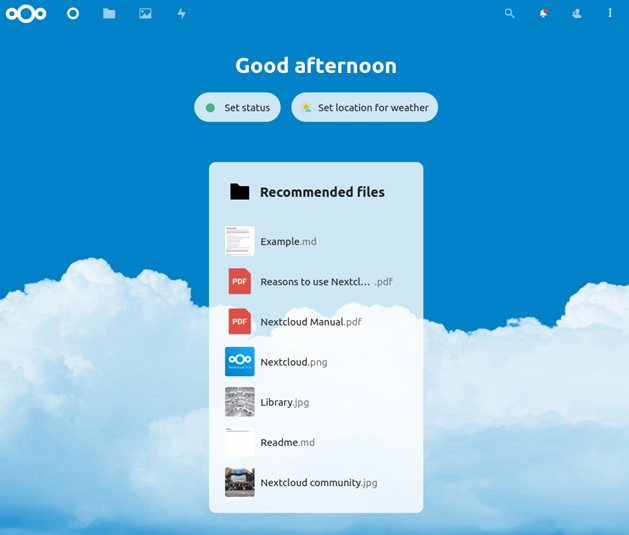
最后
以上就是冷艳眼睛最近收集整理的关于OpenWrt安装配置NextCloud的全部内容,更多相关OpenWrt安装配置NextCloud内容请搜索靠谱客的其他文章。








发表评论 取消回复